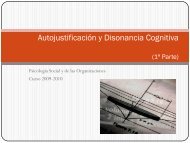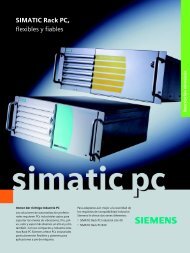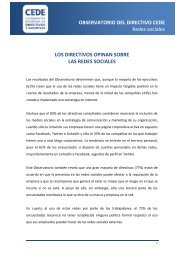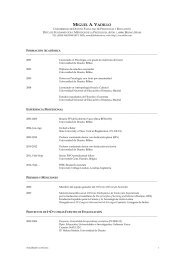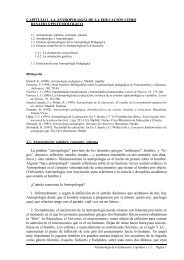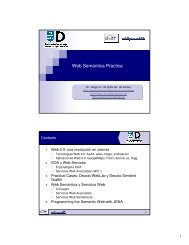Who Captures Value in a Global Innovation System? The case of ...
Who Captures Value in a Global Innovation System? The case of ...
Who Captures Value in a Global Innovation System? The case of ...
Create successful ePaper yourself
Turn your PDF publications into a flip-book with our unique Google optimized e-Paper software.
<strong>Who</strong> <strong>Captures</strong> <strong>Value</strong> <strong>in</strong> a <strong>Global</strong> <strong>Innovation</strong> <strong>System</strong><br />
<strong>The</strong> <strong>case</strong> <strong>of</strong> Apple's iPod<br />
Greg L<strong>in</strong>den, Kenneth L. Kraemer, Jason Dedrick<br />
gl<strong>in</strong>den@berkeley.edu, kkraemer@uci.edu, jdedrick@uci.edu<br />
Personal Comput<strong>in</strong>g Industry Center (PCIC)<br />
Suite 3200, Berkeley Place North<br />
Irv<strong>in</strong>e, California 92697<br />
June 2007<br />
<strong>The</strong> Personal Comput<strong>in</strong>g Industry Center is supported by grants from the Alfred P. Sloan Foundation, the U.S.<br />
National Science Foundation, <strong>in</strong>dustry sponsors, and University <strong>of</strong> California, Irv<strong>in</strong>e (California Institute <strong>of</strong><br />
Information Technology and Telecommunications, <strong>The</strong> Paul Merage School <strong>of</strong> Bus<strong>in</strong>ess, and the Vice Chancellor<br />
for Research). Onl<strong>in</strong>e at http://pcic.merage.uci.edu. For <strong>in</strong>formation, contact Jason Dedrick (949/824-2863) or<br />
Kenneth L. Kraemer (949/824-5246).
Introduction<br />
<strong>Innovation</strong> is held to be the key to U.S. competitiveness, but there is little understand<strong>in</strong>g <strong>of</strong> who<br />
captures the value from a successful <strong>in</strong>novation. This paper is a prelim<strong>in</strong>ary report on a study<br />
that will answer the question for specific examples <strong>of</strong> <strong>in</strong>novation. Here, we present a framework<br />
for analysis and use that framework to look at one member <strong>of</strong> Apple’s iPod family, part <strong>of</strong> a<br />
thriv<strong>in</strong>g ecosystem that has upended bus<strong>in</strong>ess models across the consumer electronics, computer,<br />
and enterta<strong>in</strong>ment <strong>in</strong>dustries. <strong>The</strong> iPod is a perfect example <strong>of</strong> a globally <strong>in</strong>novated product,<br />
comb<strong>in</strong><strong>in</strong>g technologies from the U.S., Japan and a number <strong>of</strong> Asian countries.<br />
In the past, large electronics companies designed and developed their own products, <strong>of</strong>ten us<strong>in</strong>g<br />
<strong>in</strong>ternally-produced components. Such highly <strong>in</strong>tegrated companies created and captured a large<br />
share <strong>of</strong> the value <strong>of</strong> <strong>in</strong>novation, mostly <strong>in</strong> their home countries. S<strong>in</strong>ce then, supply cha<strong>in</strong>s <strong>in</strong> the<br />
global electronics <strong>in</strong>dustry have steadily disaggregated across corporate and national boundaries<br />
(Sturgeon, 2002; Dedrick and Kraemer, 1998). Companies that formerly manufactured most<br />
products <strong>in</strong>-house, such as IBM and HP, as well as start-ups that never had manufactur<strong>in</strong>g<br />
capabilities, have outsourced production and even product development to global networks <strong>of</strong><br />
contract manufacturers (CMs) and orig<strong>in</strong>al design manufacturers (ODMs). Even vertically<br />
<strong>in</strong>tegrated Japanese and Korean companies rely on outside suppliers for key parts, equipment and<br />
some f<strong>in</strong>al assembly.<br />
Today the creation <strong>of</strong> a successful product <strong>in</strong> the global electronics <strong>in</strong>dustry spreads wealth far<br />
beyond the lead firm, i.e. the company whose brand appears on the product, and who bears<br />
primary responsibility for conceiv<strong>in</strong>g, coord<strong>in</strong>at<strong>in</strong>g, and market<strong>in</strong>g new products. While the lead<br />
firm and its shareholders are the ma<strong>in</strong> <strong>in</strong>tended beneficiaries <strong>of</strong> the firm’s strategic plann<strong>in</strong>g,<br />
other beneficiaries <strong>in</strong>clude partners <strong>in</strong> the firm’s supply cha<strong>in</strong> and firms that <strong>of</strong>fer<br />
complementary products or services may also benefit.<br />
<strong>The</strong> lead firms recognize how their products create potential value and they negotiate over its<br />
division with their partners. A successful firm understands that the creation <strong>of</strong> value through<br />
<strong>in</strong>novation is not a zero-sum game, and pr<strong>of</strong>its are needed all along the supply cha<strong>in</strong> to susta<strong>in</strong><br />
<strong>in</strong>novation by all participants.<br />
In this paper, we build a framework for measur<strong>in</strong>g and mapp<strong>in</strong>g the value created along a supply<br />
cha<strong>in</strong> and show prelim<strong>in</strong>ary results from an analysis <strong>of</strong> one model <strong>of</strong> the Apple iPod l<strong>in</strong>e.<br />
Conceptual framework<br />
With<strong>in</strong> a supply cha<strong>in</strong>, each producer purchases <strong>in</strong>puts and then adds value, which then becomes<br />
part <strong>of</strong> the cost <strong>of</strong> the next stage <strong>of</strong> production. <strong>The</strong> sum <strong>of</strong> the value added by everyone <strong>in</strong> the<br />
cha<strong>in</strong> equals the f<strong>in</strong>al product price. <strong>The</strong> natural start<strong>in</strong>g po<strong>in</strong>t for estimat<strong>in</strong>g these values is a<br />
map <strong>of</strong> a supply cha<strong>in</strong> show<strong>in</strong>g the activities <strong>in</strong>volved <strong>in</strong> pass<strong>in</strong>g from raw material to the<br />
consumer. A stylized supply cha<strong>in</strong> for a generic electronic product is shown <strong>in</strong> Figure 1.<br />
2
Figure 1. Generic electronics supply cha<strong>in</strong><br />
Core technologies<br />
Materials, subcomponents<br />
A few highcost<br />
<strong>in</strong>puts<br />
Many lowcost<br />
<strong>in</strong>puts<br />
CM/ODM<br />
Manufactur<strong>in</strong>g<br />
Brand name<br />
vendor<br />
IP, design,<br />
market<strong>in</strong>g<br />
Distributors<br />
Onl<strong>in</strong>e,<br />
phone<br />
sales<br />
Retail<br />
sales<br />
Distribution, sales<br />
Consumer<br />
Each product has a large number <strong>of</strong> low-value components, such as capacitors and resistors that<br />
cost only pennies each. Although the manufacturers <strong>of</strong> these components earn pr<strong>of</strong>its, they<br />
account for a small share <strong>of</strong> the total value added along the supply cha<strong>in</strong>, and contribute<br />
relatively little <strong>in</strong>novation. We expect suppliers <strong>of</strong> these generic <strong>in</strong>puts to earn th<strong>in</strong> pr<strong>of</strong>it<br />
marg<strong>in</strong>s because they compete with close substitutes.<br />
Most electronics products also conta<strong>in</strong> a few high-value components, such as a visual display,<br />
hard drive or key <strong>in</strong>tegrated circuits. <strong>The</strong>se components, which are themselves complicated<br />
systems, are the most likely to embody proprietary knowledge that helps to differentiate the f<strong>in</strong>al<br />
product and to command a commensurately high marg<strong>in</strong>. By virtue <strong>of</strong> their high cost, these<br />
<strong>in</strong>puts will usually account for a relatively large share <strong>of</strong> total value added. <strong>Innovation</strong> is rapid <strong>in</strong><br />
these components, and accounts for much <strong>of</strong> the rapid <strong>in</strong>novation <strong>in</strong> f<strong>in</strong>al products such as the<br />
iPod.<br />
<strong>The</strong>se complex components may have their own mult<strong>in</strong>ational supply cha<strong>in</strong>s. For example, an<br />
<strong>in</strong>tegrated circuit might be sold by a U.S. company but fabricated by a contractor <strong>in</strong> Taiwan and<br />
en<strong>case</strong>d <strong>in</strong> its f<strong>in</strong>al package <strong>in</strong> Korea before be<strong>in</strong>g shipped to a product assembly plant.<br />
For the assembly <strong>of</strong> these components <strong>in</strong>to the f<strong>in</strong>al product, a number <strong>of</strong> large mult<strong>in</strong>ationals,<br />
such as Flextronics, Solectron, Foxconn, Quanta, and Compal provide assembly services. <strong>The</strong>se<br />
assemblers compete fiercely for high-volume opportunities, limit<strong>in</strong>g their marg<strong>in</strong>s. Even large<br />
vertically <strong>in</strong>tegrated manufacturers such as Sony and Toshiba now outsource part <strong>of</strong> their<br />
production to these CMs and ODMs.<br />
F<strong>in</strong>ally, at the apex <strong>of</strong> the supply cha<strong>in</strong>, the lead firm contributes its market knowledge,<br />
<strong>in</strong>tellectual property, system <strong>in</strong>tegration and cost management skills, and a brand name whose<br />
value reflects its reputation for quality, <strong>in</strong>novation, and customer service. Lead firms can create<br />
value by transform<strong>in</strong>g the <strong>in</strong>novations <strong>of</strong> others <strong>in</strong>to products that consumers f<strong>in</strong>d useful and<br />
usable.<br />
Us<strong>in</strong>g this map as a guide, we calculate the value added at each stage <strong>of</strong> the supply cha<strong>in</strong> by<br />
estimat<strong>in</strong>g the sell<strong>in</strong>g price <strong>of</strong> that stage’s output and subtract<strong>in</strong>g the cost <strong>of</strong> all purchased <strong>in</strong>puts.<br />
3
A product-level study, such as we are undertak<strong>in</strong>g, allows us to break out the value embedded <strong>in</strong><br />
an <strong>in</strong>novative product and clarifies how it is distributed across the many participants <strong>in</strong> the<br />
supply cha<strong>in</strong>. Aggregat<strong>in</strong>g this firm-level data, we are able to make an <strong>in</strong>itial estimate <strong>of</strong> the<br />
distribution <strong>of</strong> value by country as well. <strong>The</strong> result will be <strong>of</strong> <strong>in</strong>terest to managers, academics,<br />
and policy makers concerned about the value captured by <strong>in</strong>novators.<br />
Data sources and analytical approach<br />
Product-level data are extremely hard to obta<strong>in</strong> directly from electronics <strong>in</strong>dustry firms, who<br />
jealously protect <strong>in</strong>formation about the pric<strong>in</strong>g deals they have negotiated, and <strong>of</strong>ten require the<br />
silence <strong>of</strong> their suppliers and contractors through non-disclosure agreements.<br />
For many electronic products, lists <strong>of</strong> components and their factory prices are available from<br />
<strong>in</strong>dustry analysts. <strong>The</strong>se “teardown” reports capture the composition <strong>of</strong> the product at a specific<br />
po<strong>in</strong>t <strong>in</strong> time. A teardown report can be used to estimate a product’s value added by subtract<strong>in</strong>g<br />
the <strong>in</strong>put prices from the wholesale price.<br />
Firm-level <strong>in</strong>formation about pure value added is not readily available because publicly-listed<br />
companies do not generally reveal the amount <strong>of</strong> their wages for “direct labor” (workers who are<br />
<strong>in</strong>volved <strong>in</strong> convert<strong>in</strong>g <strong>in</strong>puts to a salable product). Instead, the wage bill is hidden with<strong>in</strong> “cost<br />
<strong>of</strong> goods sold” or “cost <strong>of</strong> sales.” <strong>The</strong>refore, the number we will use to estimate the value<br />
captured by suppliers is “gross pr<strong>of</strong>it,” also called “gross marg<strong>in</strong>,” the difference between “net<br />
sales” and “cost <strong>of</strong> goods sold.” Gross pr<strong>of</strong>it data are readily available from annual reports <strong>in</strong> the<br />
<strong>case</strong> <strong>of</strong> public companies. Figure 2 shows the difference between value added and gross pr<strong>of</strong>it.<br />
<strong>The</strong> red area <strong>in</strong>cludes the components <strong>of</strong> value added and the blue area <strong>in</strong>cludes the components<br />
<strong>of</strong> gross pr<strong>of</strong>it, or value captured by the firm.<br />
4
Figure 2. Components <strong>of</strong> value added and gross pr<strong>of</strong>it<br />
- purchased <strong>in</strong>puts<br />
- cost <strong>of</strong><br />
- direct labor<br />
goods sold<br />
Sales - SG&A - SG&A<br />
price - R&D<br />
<strong>Value</strong><br />
Gross pr<strong>of</strong>it - R&D<br />
added<br />
- Depreciation (value captured) - Depreciation<br />
- Net pr<strong>of</strong>it - Net pr<strong>of</strong>it<br />
Gross pr<strong>of</strong>it does not equal the full value added, s<strong>in</strong>ce it excludes direct labor. Instead, it<br />
measures the value the company (exclud<strong>in</strong>g its direct workers) captures from its role <strong>in</strong> the value<br />
cha<strong>in</strong>, which it then can use to reward shareholders (dividends), <strong>in</strong>vest <strong>in</strong> future growth (R&D),<br />
cover the cost <strong>of</strong> capital depreciation, and pay its overhead expenses (market<strong>in</strong>g and<br />
adm<strong>in</strong>istration). In <strong>case</strong>s such as the iPod, where the lead company, Apple, outsources all <strong>of</strong> its<br />
manufactur<strong>in</strong>g, the value added calculated from the teardown report will be more or less<br />
identical to the gross pr<strong>of</strong>it.<br />
S<strong>in</strong>ce gross pr<strong>of</strong>it excludes wages for direct labor, it avoids the geographical ambiguity about<br />
where a product was assembled versus where the company is headquartered. <strong>The</strong> <strong>of</strong>fshore<br />
assembly aspect <strong>of</strong> value distribution needs to be captured <strong>in</strong> other ways, such as an analysis <strong>of</strong><br />
the location, quantity, and salary <strong>of</strong> jobs.<br />
<strong>The</strong> iPod Supply Cha<strong>in</strong>: an <strong>in</strong>itial view<br />
In order to beg<strong>in</strong> our supply cha<strong>in</strong> analysis, we obta<strong>in</strong>ed several “teardown” reports for various<br />
iPod models from Portelligent Inc. <strong>The</strong>se reports are based on the dismantl<strong>in</strong>g <strong>of</strong> an actual<br />
product, and they identify suppliers where known.<br />
One <strong>of</strong> these Portelligent reports details the components <strong>in</strong> the 30-gigabyte (GB) version <strong>of</strong><br />
Apple’s fifth-generation iPod, the Video iPod, which went on sale <strong>in</strong> October 2005. Table 1<br />
shows the ten most costly <strong>in</strong>puts <strong>in</strong> the 30GB iPod model based on Portelligent’s estimates. <strong>The</strong><br />
ten <strong>in</strong>puts <strong>in</strong> Table 1, <strong>in</strong>clud<strong>in</strong>g the cost <strong>of</strong> assembly and test, total $123.12, which is more than<br />
four-fifths <strong>of</strong> the estimated $144.40 total cost <strong>of</strong> <strong>in</strong>puts <strong>in</strong>to the iPod and its accessories.<br />
By far the most costly <strong>in</strong>put is the 30GB hard drive from Toshiba, which has an estimated cost <strong>of</strong><br />
$73, by itself more than 50% <strong>of</strong> total <strong>in</strong>put cost. In order to estimate the value captured by<br />
Toshiba, we will use its gross pr<strong>of</strong>it. This may be <strong>in</strong>accurate for a company like Toshiba that<br />
makes a wide range <strong>of</strong> products, from memory chips to power-generat<strong>in</strong>g facilities, but it can<br />
suffice for a first approximation. Accord<strong>in</strong>g to Toshiba’s <strong>in</strong>come statements, the gross marg<strong>in</strong><br />
for the fiscal year end<strong>in</strong>g March 2006 was 26.5% <strong>of</strong> net sales. 1 As po<strong>in</strong>ts <strong>of</strong> comparison, the<br />
gross marg<strong>in</strong>s for 2005 from the two top firms who produce only hard drives, Seagate and<br />
Western Digital, were 23.2% and 19.1%, respectively. 2 Us<strong>in</strong>g Toshiba’s overall gross marg<strong>in</strong>,<br />
1 Gross pr<strong>of</strong>it rate calculated from data at http://www.toshiba.co.jp/about/ir/en/f<strong>in</strong>ance/pl.htm.<br />
2 Calculated from Edgar Onl<strong>in</strong>e data accessed at http://f<strong>in</strong>ance.yahoo.com.<br />
5
ecogniz<strong>in</strong>g that it is on the high side for the hard drive <strong>in</strong>dustry, the value captured by Toshiba<br />
and assigned to Japan from a 30GB iPod is about $20.<br />
Table 1. <strong>The</strong> most expensive <strong>in</strong>puts <strong>in</strong> the 30GB 5th-generation iPod, 2005<br />
Component<br />
Supplier<br />
Company<br />
HQ<br />
Location<br />
Manufactur<strong>in</strong>g<br />
Location<br />
Estimated<br />
Factory<br />
Price<br />
Cost as<br />
% <strong>of</strong> all<br />
iPod<br />
Parts<br />
Gross<br />
Pr<strong>of</strong>it<br />
Rate<br />
Est’d<br />
<strong>Value</strong><br />
Capture<br />
Hard Drive Toshiba Japan Ch<strong>in</strong>a $73.39 51% 26.5% $19.45<br />
Display Module<br />
Toshiba-<br />
Matsushita Japan Japan $20.39 14% 28.7% $5.85<br />
Video/Multimedia<br />
Processor Broadcom US<br />
Taiwan or<br />
S<strong>in</strong>gapore $8.36 6% 52.5% $4.39<br />
Portal Player CPU PortalPlayer US US or Taiwan $4.94 3% 44.8% $2.21<br />
Insertion, test, and<br />
assembly Inventec Taiwan Ch<strong>in</strong>a $3.70 3% 3.0% $0.11<br />
Battery Pack Unknown $2.89 2% $0.00<br />
Display Driver Renesas Japan Japan $2.88 2% 24.0% $0.69<br />
Mobile SDRAM<br />
Memory - 32 MB Samsung Korea Korea $2.37 2% 28.2% $0.67<br />
Back Enclosure Unknown $2.30 2% 26.5%<br />
Ma<strong>in</strong>board PCB Unknown $1.90 1% 28.7%<br />
Subtotal for 10<br />
most expensive<br />
<strong>in</strong>puts $123.12 85% $33.37<br />
All other <strong>in</strong>puts $21.28 15%<br />
Total all iPod <strong>in</strong>puts $144.40 100%<br />
Source: Portelligent, Inc., 2006 and authors’ calculations<br />
<strong>The</strong> second-most valuable <strong>in</strong>put is the display, which came from Toshiba-Matsushita Display, a<br />
jo<strong>in</strong>t venture <strong>of</strong> two Japanese electronics firms. <strong>The</strong> estimated factory price was $20.39, and the<br />
average gross marg<strong>in</strong> for Toshiba and Matsushita was 28.7%, which would translate <strong>in</strong>to an<br />
additional $5.85 captured by Japan.<br />
Next are two microchips from U.S. companies, Broadcom and PortalPlayer, that control video<br />
playback and manage the iPod’s functions, respectively. <strong>The</strong>ir gross marg<strong>in</strong>s <strong>in</strong> 2005 were<br />
52.5% and 44.8%, respectively, lead<strong>in</strong>g to an estimate <strong>of</strong> $6.60 <strong>in</strong> value captured assigned to the<br />
U.S. This number is likely to be more precise than the estimate for Toshiba or Matsushita s<strong>in</strong>ce<br />
Broadcom and PortalPlayer are strictly chip companies.<br />
A similar procedure was performed for all the other <strong>in</strong>puts <strong>in</strong> Table 1 that could be assigned to a<br />
publicly-listed company. In addition to the ten <strong>in</strong>puts shown, the Video iPod has more than 400<br />
additional <strong>in</strong>puts with values from two dollars down to fractions <strong>of</strong> a penny, with an average<br />
value <strong>of</strong> $0.05 each.<br />
6
Of the ten <strong>in</strong>puts shown <strong>in</strong> Table 1, three, total<strong>in</strong>g $7.09, had no supplier mark<strong>in</strong>gs, and this<br />
identification problem becomes more prevalent for the smaller-value items. Because Apple is<br />
particularly sensitive about its supply base, field research and other <strong>in</strong>quiries will be needed even<br />
to make educated guesses.<br />
For the higher-value components, we are also research<strong>in</strong>g the next level up the supply cha<strong>in</strong> to<br />
estimate value captured by the supplier’s suppliers, especially where these have cross-border<br />
implications. In the <strong>case</strong> <strong>of</strong> PortalPlayer’s controller chip, its manufactur<strong>in</strong>g is external and<br />
could have been done either by Taiwan Semiconductor Manufactur<strong>in</strong>g Corp. (TSMC), a<br />
Taiwanese company, or LSI Logic, a U.S. company. Chip fabrication typically accounts for<br />
about a third <strong>of</strong> the factory price <strong>of</strong> a chip, so approximately $1.63 <strong>of</strong> PortalPlayer’s cost <strong>of</strong><br />
goods sold can be attributed to Taiwan or the U.S. TSMC’s gross marg<strong>in</strong> for 2005 was 44%, and<br />
LSI Logic’s was 43%, so about $0.70 was captured <strong>in</strong> this way. Moreover, PortalPlayer licenses<br />
one <strong>of</strong> the ma<strong>in</strong> elements <strong>of</strong> its chip design, the processor core, from a British company named<br />
ARM, which charges anywhere from $0.35 to $2.00 per chip (lower amounts for higher-volume<br />
deals) <strong>in</strong> royalties, which is almost pure gross pr<strong>of</strong>it and should be assigned to Great Brita<strong>in</strong>. 3<br />
A similar third-level analysis needs to be conducted for other complex parts such as the hard<br />
drive, which conta<strong>in</strong>s a number <strong>of</strong> external <strong>in</strong>puts, <strong>in</strong>clud<strong>in</strong>g chips, disks, motor, and head<br />
assembly. However, these third-level adjustments tend to be small.<br />
At the other end <strong>of</strong> the supply cha<strong>in</strong>, the retail price for the 30GB model at the time <strong>of</strong><br />
Portelligent’s analysis was $299. <strong>The</strong> difference <strong>of</strong> $154.60 between the retail price and the cost<br />
<strong>of</strong> <strong>in</strong>puts can be further decomposed <strong>in</strong>to retail, distributor, and Apple pr<strong>of</strong>it. 4 We estimate a<br />
25% wholesale discount for such units, with 10% for distribution and 15% for retail. 5 Because<br />
most <strong>of</strong> the cost <strong>of</strong> goods for the distributor and retailer is the wholesale or distribution price,<br />
their comb<strong>in</strong>ed gross marg<strong>in</strong> is roughly equal to the wholesale discount.<br />
Based on these values, Apple’s gross pr<strong>of</strong>it on those units would be $80, which is 36% <strong>of</strong> the<br />
$224 estimated wholesale price. 6 This $80 pr<strong>of</strong>it is greater than the price <strong>of</strong> any s<strong>in</strong>gle <strong>in</strong>put, so<br />
it is def<strong>in</strong>itely greater than the value added for any <strong>of</strong> its partners. And for sales made through<br />
Apple’s own web or store outlets, it reta<strong>in</strong>s an even larger share <strong>of</strong> the value.<br />
<strong>The</strong> follow<strong>in</strong>g table summarizes the preced<strong>in</strong>g analysis <strong>of</strong> the 30GB fifth-generation iPod. It<br />
assumes the unit is sold through a retail outlet <strong>in</strong> the U.S.<br />
3 Royalty rate estimate from Jim Turley, “Embedded Processors, Part One,” January 11, 2002,<br />
http://www.extremetech.com/pr<strong>in</strong>t_article/0,3998,a=21014,00.asp<br />
4 Apple, <strong>of</strong> course, reta<strong>in</strong>s the retail share <strong>of</strong> pr<strong>of</strong>it on units sold through its physical and virtual Apple Stores.<br />
5 A gross pr<strong>of</strong>it marg<strong>in</strong> <strong>of</strong> “less than 15 percent” for non-Apple sales is claimed <strong>in</strong> Damon Darl<strong>in</strong>, “<strong>The</strong> iPod<br />
Ecosystem,” New York Times, February 3, 2006, so Apple’s wholesale discount would need to be at least this large.<br />
<strong>The</strong> distribution estimate is from an <strong>in</strong>dustry <strong>in</strong>terview.<br />
6 75% <strong>of</strong> $299 is $224.25, our estimate <strong>of</strong> the wholesale price received by Apple; subtract<strong>in</strong>g the $144.40 <strong>in</strong>put cost<br />
leaves $79.85, which is 35.6% <strong>of</strong> $224.25.<br />
7
Table 2. <strong>The</strong> geography <strong>of</strong> $190 <strong>of</strong> the captured value <strong>in</strong> a s<strong>in</strong>gle $299 video iPod (very<br />
prelim<strong>in</strong>ary)<br />
U.S. Japan Korea Total<br />
Distribution and<br />
Retail $75 $75<br />
Apple $80 $80<br />
Seven Identified<br />
Inputs <strong>in</strong> Table 1 $7 $26 $1 $34<br />
PortalPlayer<br />
suppliers $1* $1<br />
TOTAL $163 $26 $1 $190<br />
Note: For this table it is assumed that the unit is sold <strong>in</strong> the U.S.<br />
* PortalPlayer suppliers could also be located <strong>in</strong> Taiwan.<br />
Source: Authors’ calculations<br />
Numerous <strong>in</strong>puts rema<strong>in</strong> to be evaluated. <strong>The</strong>y are mostly small <strong>in</strong> value, with a total cost <strong>of</strong><br />
$21.28 out <strong>of</strong> the total <strong>in</strong>put bill <strong>of</strong> $144.40. Even if the as-yet-unanalyzed <strong>in</strong>puts have a 50%<br />
gross marg<strong>in</strong>, which is unlikely, the most all these could add to any region is $10.64 (i.e. half <strong>of</strong><br />
$21.28).<br />
Some share <strong>of</strong> the $53.94 “cost <strong>of</strong> sales” <strong>of</strong> the Toshiba hard drive ($73.39 less the $19.45<br />
captured by Toshiba) will later be added to the table, most likely <strong>in</strong> the Japan column, follow<strong>in</strong>g<br />
an analysis <strong>of</strong> Toshiba’s suppliers and their marg<strong>in</strong>s.<br />
Figure 3 provides a reconciliation <strong>of</strong> the analysis so far, back to the retail price <strong>of</strong> $299. <strong>The</strong><br />
green boxes correspond to the values reported <strong>in</strong> Table 2.<br />
8
Figure 3. Breakdown <strong>of</strong> 30GB 5 th -generation iPod retail price based on analysis so far<br />
GROSS MARGIN<br />
COST<br />
Retail<br />
Price<br />
$299<br />
$45 retail<br />
marg<strong>in</strong><br />
$30 distr.<br />
marg<strong>in</strong><br />
$224 wholesale price to Apple<br />
<strong>Who</strong>lesale<br />
Price<br />
$224<br />
$80 Apple gross marg<strong>in</strong><br />
$144 cost <strong>of</strong> all <strong>in</strong>puts<br />
Cost <strong>of</strong><br />
Inputs<br />
$144<br />
(gross marg<strong>in</strong> for<br />
7 key <strong>in</strong>puts)<br />
$33<br />
$83 cost <strong>of</strong> goods for<br />
7 key <strong>in</strong>puts<br />
$28<br />
(cost <strong>of</strong> 444<br />
still-to-be analyzed <strong>in</strong>puts)<br />
Cost <strong>of</strong> sales<br />
for 7 key <strong>in</strong>puts<br />
$83<br />
$1 gross marg<strong>in</strong> for<br />
PortalPlayer supplier<br />
$4 other cost <strong>of</strong><br />
PortalPlayer chip<br />
$78 still-to-be analyzed<br />
cost for 7 key <strong>in</strong>puts<br />
Source: Authors’ estimates; see text.<br />
<strong>The</strong> dom<strong>in</strong>ance <strong>of</strong> Apple’s gross marg<strong>in</strong> suggests that <strong>in</strong> this particular iPod model, the U.S.<br />
captures most <strong>of</strong> the value. In the <strong>case</strong> <strong>of</strong> retail units sold <strong>in</strong> other countries, a significant portion<br />
<strong>of</strong> the U.S. share would shift elsewhere. For a unit sold <strong>in</strong> Japan, the total value captured by<br />
Japanese companies might even be larger than the U.S. share, depend<strong>in</strong>g on the identity <strong>of</strong> the<br />
company that handles distribution.<br />
However, it must be recalled that the gross marg<strong>in</strong>s for <strong>in</strong>puts <strong>in</strong> the third row <strong>of</strong> Figure 2<br />
exclude direct labor, which is part <strong>of</strong> the $83 cost <strong>of</strong> goods. Direct labor, most <strong>of</strong> which will be<br />
outside the U.S., would be <strong>in</strong>cluded <strong>in</strong> an ideal value added analysis but will not be accounted for<br />
<strong>in</strong> the current phase <strong>of</strong> the study because <strong>of</strong> data availability problems. 7<br />
<strong>The</strong> location <strong>of</strong> direct labor differs from headquarters location for most electronics firms.<br />
Taiwanese CMs, for <strong>in</strong>stance, have moved the bulk <strong>of</strong> their factories to ma<strong>in</strong>land Ch<strong>in</strong>a over the<br />
last decade, reta<strong>in</strong><strong>in</strong>g some high-end manufactur<strong>in</strong>g <strong>in</strong> Taiwan and a few assembly factories <strong>in</strong><br />
other low-cost regions such as Eastern Europe. In the <strong>case</strong> <strong>of</strong> the iPod’s hard drive, Toshiba has<br />
shifted much <strong>of</strong> its hard drive manufactur<strong>in</strong>g from Japan to the Philipp<strong>in</strong>es and Ch<strong>in</strong>a.<br />
7 <strong>The</strong>se wage and worker issues are planned as a subject <strong>of</strong> future research.<br />
9
Conclusions<br />
So what can we say about who captures the value <strong>of</strong> <strong>in</strong>novation, based on this <strong>in</strong>itial analysis<br />
First, the biggest w<strong>in</strong>ner is Apple, an American company, with predom<strong>in</strong>antly American<br />
employees and stockholders who reap the benefits. If the iPod had been made by Sony or<br />
Samsung, the value to the U.S. would be considerably less.<br />
Second, the producers <strong>of</strong> high value, critical components capture a large share <strong>of</strong> the value. For<br />
the 30GB Video iPod, the highest value components are the hard drive and the display, both<br />
supplied by Japanese companies. U.S. suppliers provide the two most valuable microchips.<br />
Third, trade statistics can mislead as much as <strong>in</strong>form. For every $300 iPod sold <strong>in</strong> the U.S., the<br />
politically volatile U.S. trade deficit with Ch<strong>in</strong>a <strong>in</strong>creased by about $150 (the factory cost). Yet,<br />
the value added to the product through assembly <strong>in</strong> Ch<strong>in</strong>a is probably a few dollars at most.<br />
While Apple’s share <strong>of</strong> value capture is high for the <strong>in</strong>dustry, the iPod’s overall pattern <strong>of</strong> value<br />
capture is fairly representative.<br />
Today, no s<strong>in</strong>gle country is the source <strong>of</strong> all <strong>in</strong>novation and therefore U.S. companies need to<br />
work with <strong>in</strong>ternational partners to br<strong>in</strong>g new products to market. <strong>The</strong>se companies will capture<br />
pr<strong>of</strong>its commensurate with the extra value they br<strong>in</strong>g to the table. This is simply a fact <strong>of</strong><br />
bus<strong>in</strong>ess <strong>in</strong> the 21 st century, and the good news is that many American companies are w<strong>in</strong>n<strong>in</strong>g<br />
this game and cont<strong>in</strong>u<strong>in</strong>g to br<strong>in</strong>g significant benefits to the U.S. economy.<br />
As long as the U.S. market rema<strong>in</strong>s dynamic, with <strong>in</strong>novative firms and risk-tak<strong>in</strong>g<br />
entrepreneurs, global <strong>in</strong>novation should cont<strong>in</strong>ue to create value for American <strong>in</strong>vestors and<br />
well-paid jobs for knowledge workers. But if those companies get complacent or lose focus,<br />
there are plenty <strong>of</strong> foreign competitors ready to take their places. If this happens, the benefits<br />
from the global <strong>in</strong>novation system could quickly shift away from the U.S.<br />
References<br />
Darl<strong>in</strong>, Damon. (2006). <strong>The</strong> iPod Ecosystem. New York Times, February 3, 2006.<br />
Dedrick, Jason, and Kenneth L. Kraemer. (1998). Asia’s Computer Challenge: Threat or<br />
Opportunity for the United States and the World New York: Oxford University Press.<br />
Portelligent Inc. (2006). Apple iPod Video, 30GB Multimedia Player - Report #150- 061118-JEf.<br />
Aust<strong>in</strong>, TX: Portelligent Inc.<br />
Sturgeon, Timothy J. (2002). Modular Production Networks: A New American Model <strong>of</strong><br />
Industrial Organization. Industrial and Corporate Change 11(3): 451–96.<br />
Turley, Jim. (2002). Embedded Processors, Part One. ExtremeTech.com, January 11, 2002.<br />
Retrieved from, http://www.extremetech.com/pr<strong>in</strong>t_article/0,3998,a=21014,00.asp<br />
10






